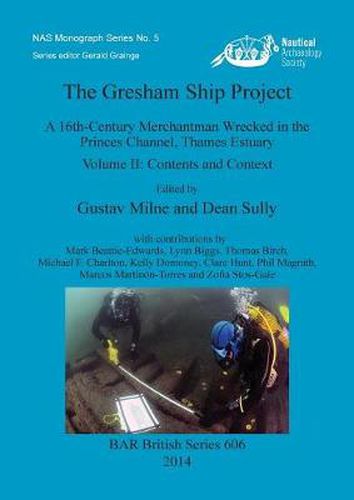Readings Newsletter
Become a Readings Member to make your shopping experience even easier.
Sign in or sign up for free!
You’re not far away from qualifying for FREE standard shipping within Australia
You’ve qualified for FREE standard shipping within Australia
The cart is loading…






This title is printed to order. This book may have been self-published. If so, we cannot guarantee the quality of the content. In the main most books will have gone through the editing process however some may not. We therefore suggest that you be aware of this before ordering this book. If in doubt check either the author or publisher’s details as we are unable to accept any returns unless they are faulty. Please contact us if you have any questions.
Sometime in the late 16th to early 17th century an armed merchantman foundered in the Thames Estuary. Forgotten for over four centuries, it was rediscovered in 2003 as the Port of London Authority began clearing navigational hazards from the Princes Channel. Wessex Archaeology were alerted and recovered five sections of the ship’s hull and four guns, as well as numerous artefacts. The first report in this two-volume set presented studies of the hull compiled by the University of Southern Denmark. The second volume describes the research undertaken at University College London on the wider maritime context, the conservation process and the analysis of the contents recovered from the wreck site. Prominent in the cargo were 42 iron bars thought to be of a type - so-called ‘voyage iron’ - sometimes traded to West Africa as the first stage of the transatlantic slave trade. With a tonnage of some 150 tons, the Gresham Ship emerges from this research as an all too rare example of typical armed merchantman of the age, capable of ocean passages, operating as a privateer or even serving with the Queen’s Navy against the Armada.
$9.00 standard shipping within Australia
FREE standard shipping within Australia for orders over $100.00
Express & International shipping calculated at checkout
This title is printed to order. This book may have been self-published. If so, we cannot guarantee the quality of the content. In the main most books will have gone through the editing process however some may not. We therefore suggest that you be aware of this before ordering this book. If in doubt check either the author or publisher’s details as we are unable to accept any returns unless they are faulty. Please contact us if you have any questions.
Sometime in the late 16th to early 17th century an armed merchantman foundered in the Thames Estuary. Forgotten for over four centuries, it was rediscovered in 2003 as the Port of London Authority began clearing navigational hazards from the Princes Channel. Wessex Archaeology were alerted and recovered five sections of the ship’s hull and four guns, as well as numerous artefacts. The first report in this two-volume set presented studies of the hull compiled by the University of Southern Denmark. The second volume describes the research undertaken at University College London on the wider maritime context, the conservation process and the analysis of the contents recovered from the wreck site. Prominent in the cargo were 42 iron bars thought to be of a type - so-called ‘voyage iron’ - sometimes traded to West Africa as the first stage of the transatlantic slave trade. With a tonnage of some 150 tons, the Gresham Ship emerges from this research as an all too rare example of typical armed merchantman of the age, capable of ocean passages, operating as a privateer or even serving with the Queen’s Navy against the Armada.